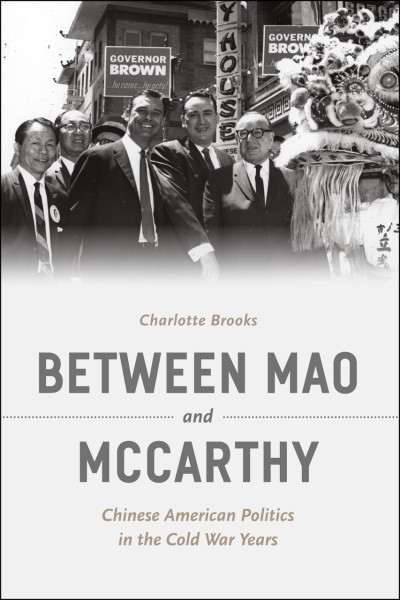Charlotte Brooks’ new book, Between Mao and McCarthy, is an impressive scholarly tome on the evolution of Chinese American politics in the years after World War II. It looks specifically at the evolution of politics in New York and San Francisco–the main Chinese populations in the United States. Brooks examines how Chinese Americans turned from a predominant focus on China politics to a distinctly Chinese American politics rooted in improving their livelihoods in the United States and partaking in Democratic and Republican party politics.
Brooks’ inclusion of the prominent voices in community newspapers and her detailed information about the power players within New York and San Francisco lend an insider’s view on a turbulent time for Chinese American communities–amidst red-baiting and the evolving conflict between the PRC and ROC. Such stories and voices showcase and shed new light on a dynamic and evolving conversation about the role of local, regional, national, and international politics in Chinese American life.
Her analysis, in showing how New York and San Francisco’s Chinese American politics developed differently, also provides intriguing insight into how to think about the differences between the Chinese American populations and politics in the two cities today.
The 1950’s marked a great change on the national level for Chinese and Asian American communities. For Chinese, World War II brought about the repeal of the Chinese Exclusion Laws which barred Chinese laborers from entering beginning in 1882, led to the formation of the paper sons and daughters system to circumvent immigration legislation, and precluded Chinese from naturalizing as citizens. All this was overturned and Chinese could become American citizens beginning in 1943 (though only a nominal 105 could immigrate a year until new legislation in 1965). Filipinos and Indians earned naturalization rights in 1946, while other Asian immigrants would have to wait until 1952. (Those born on American soil were citizens via the 1898 court case Wong Kim Ark vs. United States which guaranteed birthright citizenship via the Fourteenth Amendment).
In the transition from the local power structures in the two cities from the 1930’s t the 1950’s, San Francisco developed a distinct Chinese American politics which stumped for local candidates that would make improvements for the Chinese community and had good records on immigration issues. With an increasing number of voting citizens as a part of its population, San Francisco Chinese Americans integrated more effectively into local, regional, and eventually national politics. Meanwhile, in New York City, the predominantly alien-born population, along with the city’s selection as the site of the UN headquarters, led the city’s Chinese to remain caught up in KMT and ROC politics and found themselves less able to ally themselves with local politicians.
West Coast journalist Gilbert Woo astutely noted at the time the dangers in getting too caught up in China politics given views about communism prevailing in American society.
“We are exactly the same as other American citizens and as individuals can discuss our opinions of the situation in China, but we shouldn’t take part in actual Chinese politics. No matter which side we join, it will affect our citizenship rights, because other people will proclaim that we’re not real citizens.”
Voices from the time, like this one, pepper Between Mao and McCarthy, showcasing how robust conversations were at the time. They also provide an ideal counter-balance to the author’s lengthy (but impressively detailed) explanations of shifting power structures and political maneuvering. In time, Chinese Americans worked to best situate themselves within local politics to protect and advocate for their rights as citizens, voters, and community members. Immigration and housing were two important rallying points and barometers for political success in Chinatown.
Aside from the main argument about this shifting balances between China politics and Chinese American politics, one of the most interesting points Brooks makes is connected with Woo’s point about asserting identity and rights as citizens. In the last chapter, the author writes about early Chinese American self-identification as “Orientals” in the 1950’s and early 1960’s. While the term is commonly thought of to be solely one of outsiders defining a community in a derogatory manner, Brooks shows how some activist Asian Americans (in the years before that was a term) sought to create an identity (and group) that could advocate for a broad Asian-descent community and a more politically useful and meaningful manner. Pan-Asian American activism is more commonly attributed to the Asian American movement of the late 1960’s, but these early seeds of community work deserve further exploration and attention.
Between Mao and McCarthy joins a recent emergence of new scholarship on Chinese Americans during this contentious historical period–including Ellen Wu’s The Color of Success and Madeline Hsu’s The Good Immigrant. For those interested in this time period of history or in twentieth-century Chinese American history, it’s well worth a read.








